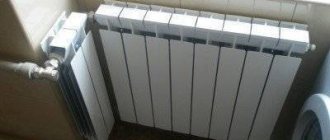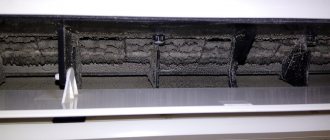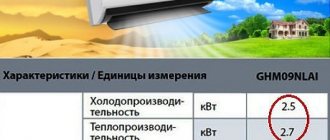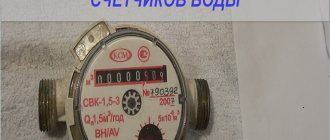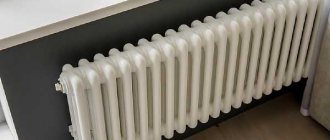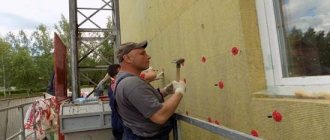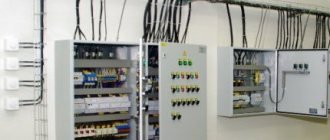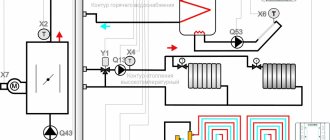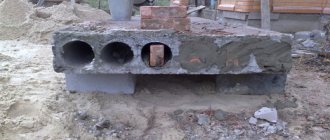If there was a “Grandfather Heat”, then in letters to him children and adults would ask for only one thing - to give him an air conditioner.
Today, many cannot imagine their existence without this most useful device, and the cheerful spring drops heard near high-rise buildings with the arrival of summer serve as further confirmation of this.
In this article we will analyze the principle of operation of the air conditioner and the design of the equipment.
Air conditioning device
With all their diversity, air conditioners of different models are based on the same device - a heat pump. This ingenious mechanism allows for heat exchange in an “unnatural” direction, that is, from a colder environment to a hotter one.
Let us show schematically how it works:
- Let's take two containers with a certain medium, and the temperature in the 1st container is lower than in the 2nd. Place the vessel with gas in the 1st container and wait until the temperatures of the gas and the medium are equal.
- Let's move the gas into the 2nd container and compress it so that its temperature (remember that gases heat up during compression) is higher than the temperature of the medium in this container. Due to the temperature difference, heat exchange will begin, that is, the gas will begin to release thermal energy to the environment of the 2nd container.
- Let's move the gas again into the 1st container, returning it to its original volume. During expansion, the gas will cool down and, since part of the internal energy was lost by it at the previous stage, its temperature will be lower than it was at the beginning. That is, the gas after expansion will be colder than the medium in the 1st container. Again, heat exchange will take place, only in the medium-gas direction. After balancing the temperatures, transfer the gas again to the 2nd container, not forgetting to compress it. So the heat will gradually be “pumped” from the cold substance to the hot one.
Heat pumps work not only under the guise of air conditioners, but also refrigerators, dehumidifiers, geothermal heating systems, etc. The gas used in them is called a refrigerant, usually freon is used in this capacity.
The design and principle of operation of the air conditioner
The refrigerant circulates through a closed pipe circuit consisting of two parts: a condenser, in which the gas is compressed to a liquid state, and an evaporator, in which the refrigerant evaporates, again turning into a gas and expanding in volume.
The gas enters the condenser from the evaporator using a compressor (it performs compression). From the condenser, the refrigerant gradually leaks back into the evaporator through a long thin tube twisted into a cylindrical spiral (called a capillary, throttle or thermostatic valve).
Types of air conditioners
Today, in addition to conventional air conditioners, which periodically turn on and off, so-called inverter devices are produced.
An inverter is an electronic unit that allows you to change the frequency of the electric current as desired. In this case, the compressor power will change accordingly.
Thus, the inverter air conditioner does not need to be turned off - it works constantly, choosing the optimal cooling power.
The room temperature remains fixed, and the device lasts longer than its non-inverter counterparts (start-up times greatly shorten the life of power generating units).
Air conditioners can also be:
- Recirculating - they simply circulate the air of the room through themselves.
- With the possibility of mixing in outside air: these devices are more expensive than recirculation ones, but the air in the room where they are installed not only becomes cool, but also remains fresh.
According to the method of assembling units, air conditioners are divided into two types: monoblocks and split systems.
Most air conditioners have a heating function, but not everyone knows how to turn the air conditioner on. We will talk about this in the article.
We will consider the types and design of a boiler for heating water here.
And in this topic https://microklimat.pro/sistemy-otopleniya/montazh-sistem-otopleniya/sxema-otopleniya-dvuxetazhnogo-doma.html an overview of heating schemes for a two-story house is presented. Vertical and horizontal options.
Monoblocks
All the “filling” of such a device is located in one housing, due to which the product has a low cost. There are the following types of monoblocks:
- Window: installed in a window or wall opening so that the condenser is outdoors and the evaporator is indoors.
- Roof: installed similarly, only in the roof.
- Mobile: the entire device stands on the floor indoors, and the air that blows over the hot condenser is discharged outside through an air duct.
Mobile air conditioner
In order to gain in price, the owner of a monoblock has to endure noise from the compressor and put up with heat leaks in winter through the body of the device (the latter is true for window and roof models).
Split systems
The device consists of two parts, one of which is located indoors and the other outdoors. If there is one outdoor unit and several indoor units, the device is called a multi-split system. Such air conditioners are the most popular today, so we will look at their operation in more detail.
Technical characteristics of the indoor unit
To choose the optimal air conditioner model, you should pay close attention to the technical characteristics of the device. Each manufacturer may have its own set of performance characteristics, but the main list of indicators is the same for all and includes the following items:
- Power consumption. Often the general value is indicated for the outdoor and indoor units, where the indoor module consumes only a small part - no more than 100-200 W.
- Heating power.
- Cooling power.
- Air flow. Shows how much air the device is capable of passing through itself per unit of time.
- Device dimensions.
- Weight.
- Recommended area. Makes it easier for consumers to choose by showing for what volumes of premises the device will be optimal.
All this data is recorded in the accompanying documentation, as well as on the information panel on the device itself.
System operation
Let's look at how an air conditioner works. Let's start with the operating principle of a split air conditioner system. So, a split system consists of the following components.
Air conditioner outdoor unit
There is a condenser with a fan blowing it and a compressor. Thus, the noisiest units ended up on the street, which is the main advantage of split systems.
Let's look at the operating principle of an air conditioning compressor. The compressor compresses the refrigerant to a pressure of 20 - 25 atm, as a result of which its temperature rises to 90 degrees. Piston compressors are the cheapest, but their reliability leaves much to be desired, especially if it’s cold outside. More expensive scroll compressors do not have this disadvantage.
The principle of operation of a split system for cooling
Models in which the outdoor unit fan rotates at a constant speed operate effectively only within a narrow range of outdoor temperatures. In more “advanced” air conditioners, the fan speed is smoothly or stepwise regulated depending on the temperature.
Through the capillary, freon is gradually pressed into the tube leading to the second part of the device. It is called…
Indoor unit
An evaporator is placed here, which is also blown by a fan. In addition, there is a control board, an air filter and a tray for collecting condensate (discharged through a drain hose).
The freon pressure in the evaporator is 4 - 5 atm, while it cools down to a temperature of less than 10 degrees.
Based on the type of indoor unit (IB), split air conditioners are divided into the following types:
- Wall-mounted: The VB is placed on the wall in its upper part. Cooled air is supplied directly to the room.
- Cassette: installed in the center of the ceiling with the expectation that all communications will be hidden by the suspended ceiling. The VB itself has the same dimensions as a standard ceiling tile - 60x60 cm. Powerful models have a double size - 120x60 cm. Cooled air is also supplied directly to the room, but, unlike the wall version, in four directions at once. Thanks to this, it is possible to effectively cool a room with a much larger area.
- Duct: The duct type WB is completely hidden behind the suspended ceiling, and the cooled air is supplied through a network of air ducts. Thus, with the help of one WB it is possible to cool the air in several rooms.
Design of the indoor unit of the air conditioner
Most modern air conditioners can operate in two modes:
- Cold operation of the air conditioner: This is a normal mode in which the condenser is placed outside and the evaporator is placed indoors.
- The air conditioner works for heat.
In air conditioners capable of operating in heating mode, the external and internal parts of the circuit can change roles: the internal part becomes a condenser, and the external part becomes an evaporator. To do this, a jumper and a 4-way valve are added to the circuit, which directs the refrigerant to one or another line.
The peculiarity of air conditioning heaters is that their thermal power is 3–4 times higher than the consumed electrical power, whereas for conventional electric heaters both these parameters have equal values.
DIY air conditioner installation: diagram and detailed instructions
Not so long ago, some 20 years ago, air conditioners were considered the lot of either big bosses or very rich citizens. In fact, these air conditioning units were installed in “high” offices, luxury hotel rooms or, much less commonly, in the own homes of wealthy people. However, nowadays the convenience of such household appliances is appreciated by the widest segments of the population, it is no longer unaffordable, and now no one is surprised by air conditioners, which are available almost everywhere.
DIY air conditioner installation
As a rule, companies involved in the sale of climate control equipment, in most cases, take care of its installation, debugging and commissioning. Of course, this service is not free, and its cost can be quite significant even compared to the price of the air conditioner itself. Therefore, probably, potential buyers are often concerned with the question: is it necessary to resort to the help of craftsmen? Is it possible to install the air conditioner yourself?
There is no clear answer to this question. And the air conditioners themselves are different, and the levels of technical preparedness of homeowners can vary significantly. In addition, the specific location of the living space in which it is planned to install such a device is of great importance - very often it is simply impossible to carry out independent installation without specialized equipment, equipment or construction equipment.
And in order to immediately be able to assess the complexity of the task at hand, you need to at least understand a little about the principle of operation of the air conditioning unit - what causes the sharp cooling of the air passing through it?
Basic principles of operation of a household air conditioner
If we reason from the standpoint of physical laws, then in order for cooling to occur in one place of a certain balanced system, then in another area this must be compensated for by corresponding heating. How to achieve this?
Everyone knows that the evaporation of liquid from the surface of an object is always accompanied by the absorption of heat and, accordingly, rapid cooling of this surface. It is enough to remember that, for example, a wet palm feels much cooler than a dry one. Wet compresses on the forehead of a sick person when the temperature rises is also one of the practical methods of using this principle. Conversely, condensation of steam into a liquid state occurs with the release of heat. This means that it is necessary to create conditions so that in one single system the liquid in one area actively evaporates, and in another, under the influence of some external influence, condenses, giving off heat. This is exactly how almost all refrigerators, freezers and air conditioners are designed.
The principle diagram of the operation of any air conditioner is shown in the following figure:
Operating principle of the air conditioning unit
This unit can be divided into two halves - external and internal. In split systems, this division occurs “literally” - with division into appropriate blocks. In monoblock models this is not so noticeable visually, since the entire structure is arranged in a single housing, but the operating principle does not change.
So, both the external and internal parts of the air conditioning unit have their own tubular radiator, however, they perform exactly the opposite functions. In the outdoor unit it plays the role of a condenser, and in the indoor unit it plays the role of an evaporator. They are connected to each other by sealed pipelines. A special substance, the so-called refrigerant, is constantly pumped through this closed circuit using a compressor.
The main requirement for such a refrigerant is a fairly high boiling point compared to atmospheric gases, no likelihood of freezing (transition to a solid state of aggregation), and high volatility. At the dawn of the production of refrigeration units and air conditioners, ammonia was most often used in this capacity. However, the vapors of this chemical compound are very dangerous for the human body, and therefore, over time, it was widely replaced by freons - special synthetic gases (or mixtures of gases) developed specifically for such purposes. Until recently, R-22 freon was most often used in most air conditioners, but in a number of countries its use is already banned as a substance leading to the destruction of the Earth's ozone layer. R-410A freon is more modern, advanced and safe. Their boiling point, that is, the active transition from liquid to gaseous state at normal atmospheric pressure, is approximately minus 50 ° C.
Standard different types of freons
However, as is known from the course of thermodynamics, the process of phase transition of a substance from one state of aggregation to another depends not only and even not so much on temperature, but on pressure. This means that, through special devices, it is necessary to create conditions for active condensation of the refrigerant outside, and, accordingly, evaporation inside the room. This is achieved by the operation of the compressor and the presence of a special throttling device (thermostatic valve).
If we take a closer look at the work cycle, it looks like this:
- At the compressor inlet, the refrigerant is in a gaseous state at a relatively low pressure.
- The compressor ensures the movement of freon through the system, while significantly increasing the degree of its compression before entering the condenser radiator. An increase in pressure is, of course, accompanied by a significant increase in temperature. The flow of cold outside air supplied by the fan removes heat, simultaneously activating the process of condensation of the refrigerant - its transition to a semi-liquid state.
- Moving through the pipes, freon, before entering the evaporator, passes through a throttling device - a thermostatic valve. Due to the special configuration of the passage, the pressure in the line decreases sharply, which causes a rapid, almost avalanche-like boiling of the refrigerant with its evaporation, transition to a gaseous state and, accordingly, a sharp drop in temperature.
- The indoor unit fan ensures that air flows in the room through the evaporator radiator. with its cooling.
- From the evaporator, the freon returns to the compressor unit, thus completing the cycle.
The design of the throttling device can be different - from a capillary tube to a complex multi-port valve, which allows not only to accurately regulate the freon cooling temperature. Such a mechanism is capable of “redirecting” the activity of the units, turning the evaporator into a condenser and vice versa - this is used when switching many models of air conditioners to the “winter” mode - to heat the room.
Of course, modern air conditioners are high-tech devices with a lot of additional control, management, and service functions, but their operating principle is the same.
Main types of household air conditioners
It is impossible to understand the rules for installing air conditioners if, in addition to the principle of operation, you do not understand the design features of the various types of these household appliances.
First of all, all air conditioners can be divided into two large categories - monoblock (assembled in one housing) and split systems (having two separate units or more).
Monoblock air conditioners
The entire circuit diagram of the air conditioner is assembled in one housing. The “external” and “internal” working blocks are separated by a partition, which in many models is adjustable, allowing air to penetrate from the room to the outside and back for ventilation or recovery.
They may also differ in installation method:
- Window air conditioners - the name speaks for itself. The unit is installed in a window opening so that the main part of the housing is outside, and only the control panel and blinds remain in the room to direct the cooled air flow.
This is how a window monoblock air conditioner is usually designed.
The advantages of such a scheme are obvious:
— All internal pipelines are already assembled at the factory, freon filling is carried out there, that is, the installation of the air conditioner itself is greatly simplified, and comes down mainly to general construction or carpentry work.
— Such models allow you to work in forced ventilation mode.
— The price of such air conditioners is low, and given the absence of the need for complex installation, then from an economic point of view this is the best option.
There are also many disadvantages.
— A fairly large monoblock seriously reduces the intensity of the light flux from the window, reducing the natural illumination of the room (often, to avoid this, monoblocks are mounted in a specially made opening in the wall).
— The air conditioner itself becomes a “cold bridge” from the street to the room in winter. It is necessary to consider dismantling it at this time with a hermetically sealed insulated seal of the opening, or somehow otherwise solve the problem of thermal insulation.
— Such an air conditioner does not fit well into a double-glazed window system, unless, of course, when installing PVC windows, its installation was not thought out in advance.
Monoblock “windows” fit well into the interior of the room
— A monoblock air conditioner is “tied” to one place, and will not always be able to evenly distribute cooled air throughout the entire volume of the room. In addition, window curtains, curtains, blinds, etc. often interfere with this.
— As a rule, such air conditioners have a fairly high noise level.
- Mobile monoblock air conditioners are mobile (usually equipped with wheels for ease of movement) devices that are installed as needed in a particular room. Externally. As a rule, they resemble a bedside table with a system of blind guides on the body and control devices.
Mobile air conditioner in operation
Both the condenser and the evaporator are located in one housing. There must be a flexible hose to remove warm air from the condenser outside, outside the room.
Schematic diagram of a mobile air conditioner
Advantages of this type of air conditioners:
— The need for complex installation is completely eliminated - no connections, sealing, refills, electrical connections, etc. Everything is based on the “plug in and use” principle; you just need to bring the flexible sleeve out through a window or hole in the wall or window block. (There are, however, more complex models that even have an external unit. But this type, perhaps, can even be classified as a split system, since the installation of such air conditioners takes more than one hour, and they can only be called mobile with a very big stretch ").
— It is possible to move the air conditioner from room to room, take it with you to the dacha, and it is not at all difficult to put it away for storage in the winter when it is no longer needed.
Disadvantages of the “mobile” scheme:
— Mobility is quite conditional, since it is limited by the length of the corrugated hose for removing heated air. Usually this is no more than 1.5 ÷ 2 m from the window.
— Water condensate resulting from air cooling is not discharged outside, but accumulates in the air conditioner pan. Thus, regular maintenance is required - draining the accumulated water, otherwise the device simply stops.
— Such air conditioners are quite noisy.
— The cost of such a device is very high, comparable to the price of a high-quality split system with disproportionately lower performance indicators.
- Whatever one may say, such an air conditioner clutters up the room, especially if it is a small area.
Split systems
Of all modern air conditioners, they are now the most common. Their main feature is that the condensation and evaporation units are made in different housings and are separated - installed outside and inside the room. At the same time, all the noisiest components of the air conditioner (in particular, the compressor unit) are placed outside, that is, the overall noise level of such an air conditioner is minimal.
What is the approximate layout of air conditioners based on the split system principle? Of course, different manufacturers and different models may have their own characteristics, but the general scheme is approximately the same.
First, the outdoor unit.
Diagram of the external unit of the split system
The fan (item 1) on the axis of the electric motor is used to create, as necessary, an air flow to remove heat from the radiator-condenser (item 2)
Pumping the refrigerant and maintaining the required pressure in its circulation circuit is ensured by the compressor (item 3). This unit can be piston (cheaper and quieter) or spiral (more expensive, but more reliable, especially in conditions of low air temperatures).
The electronics unit (item 4) - can, by the way, be located not in the external, but in the internal unit, where it will be less exposed to the influence of the external environment. Ensures the correct operation of all electrical and electronic systems and mechanisms.
A mandatory element is a thermostatic valve (item 5). This figure shows an option using a four-way valve, typical for “winter-summer” models that work both for air cooling and heating.
As a rule, on the right end part of the external block at the bottom (item 6) there are fitting connections through which the connection is made with the internal block. For greater safety, this unit is usually covered with a protective casing (item 8). Usually on the same side, only on top, there is a terminal part for electrical switching of both blocks.
Before the line enters the compressor, a special freon filter is usually installed, which should prevent small particles, for example, copper chips or other inclusions, from entering the system along with the refrigerant.
Now - the structure and layout of the indoor unit. However, if there is usually monotony with the external unit, then several options are possible here, depending on the specific type of split system.
The most common are wall-mounted units of split systems
- Thus, air conditioners can be wall-mounted - the most common in residential premises. The indoor unit is placed on the wall in a location convenient for the user.
Duct split system
- If you need to organize air cooling and ventilation in several rooms, you often resort to installing a ducted split system, which is usually located above a suspended ceiling.
The cassette unit looks very good on the ceiling
- The cassette-type split system unit is placed in the same plane with the ceiling and ensures uniform distribution of air in all directions. Such air conditioners fit very well into the interior of rooms with suspended ceilings of a modular design.
Floor-ceiling type unit
- Indoor units of the floor-ceiling type, as the name implies, are placed either vertically on the floor along the wall, or horizontally on the plane of the ceiling.
Column air conditioner - In some public spaces it is not possible to use walls or ceilings to place the units (for example, museums, exhibition halls, historical buildings), or the need to install the unit in the center of the room prevails for uniform distribution of air flows. In these cases, they resort to installing a split system with a column-type block.
One external unit and several internal ones - multi-split system
- Finally, one external unit can be equipped with several internal ones of one type or another. This kit is called a multi-split system.
However, as already mentioned, in private houses and apartments, wall-mounted split systems are currently the most common. The schematic diagram of just such a block will be discussed below:
Diagram of the indoor unit of a conventional split system
- The outer plastic casing (item 1) of the unit is essentially a grille with holes for air intake. This panel can be easily removed for maintenance work.
- Below it there is a coarse air filter (item 2) - a polymer fine mesh for trapping dust suspended in the air, pet hair, etc. This filter must be cleaned regularly - usually at least once a month.
- Many air conditioners also install fine filters and (or) air deodorization (item 3). They can be of various types - carbon, electrostatic and others.
- The movement of air flows in the room is ensured by a fan built into the unit (item 4), which, as a rule, has the ability to adjust the rotation speed in multiple stages.
By the way, the comfort of the microclimate in the room largely depends on the intensity of the air flow. Thus, by increasing the speed of air movement, you can save on much higher energy costs for cooling it (the effect of a conventional fan):
| Air flow speed m/s | She is also km/hour | Perceived cooling effect (minus degrees C) |
| 0,1 | 0,36 | 0 |
| 0.25 | 0.9 | 0,5 |
| 1.5 | 5.4 | 4 |
| 3 | 10.5 | 6 |
| 5 | 18,0 | 7 |
| 8 | 28,8 | 8 |
| 10 | 36,0 | 9 |
- The process of evaporation and sudden cooling takes place in the evaporative radiator of the unit (item 5) - a system of thin tubes with refrigerant circulating through them.
- The direction of the air flow is determined by the blind systems.
 Horizontal (position 6) regulate the movement of cooled air in the vertical plane. They can stand still or change their position in accordance with the selected work program. Vertical blinds (items direct the flow in a horizontal direction. In inexpensive models they are most often adjusted manually, and in some premium air conditioners the ability to control them remotely is implemented.
Horizontal (position 6) regulate the movement of cooled air in the vertical plane. They can stand still or change their position in accordance with the selected work program. Vertical blinds (items direct the flow in a horizontal direction. In inexpensive models they are most often adjusted manually, and in some premium air conditioners the ability to control them remotely is implemented. - Indication and control panel (item 7) - usually includes a remote control signal receiver window, several LEDs and an indicator panel. Serves to display the operating modes of the air conditioner and signals possible malfunctions or system failures. Sometimes the panel may have several buttons for manual control of the system.
Several other important elements are not visible on the diagram, but require mandatory mention:
- In the lower part at the back, under the decorative casing, there are two copper pipelines with connection fittings for connection to the external unit.
- The process of intensive cooling of indoor air is always accompanied by abundant formation of condensation on the radiator tubes. The condensed moisture flows into a special tray, from where it is removed outside through a laid drainage pipe.
- Hidden under the decorative casing is an electronics board and a patch panel for connecting the electrical part of the split system. A network cable is connected here to connect the supply voltage and wires connecting the outdoor unit to the indoor unit.
Once the reader has gained an idea of the design and operating principles of household air conditioners, it will be easier for him to understand the rules for their installation.
Find out how to make an air conditioner with your own hands, as well as familiarize yourself with several simple models, from our new article.
Prices for the range of air conditioners
Air conditioners
How to install an air conditioner yourself
In order not to create unnecessary illusions in readers, it must be said right away that installing any air conditioner (with the possible exception of a mobile one) is a task of a high level of complexity and increased danger. This is due to the fact that the process involves the installation of very heavy blocks, and work is often carried out at high altitudes, which requires special care and qualifications of the installer.
In addition, we must not forget that air conditioners are complex equipment, the installation of which should only be carried out by specialists. Thus, carrying out self-installation, with a probability close to 100%, will deprive the owner of any manufacturer’s warranty obligations both in terms of service and for replacement or repair work if a manufacturing defect is detected.
If the installation of a monoblock is not associated with laying pipelines, drying, filling and sealing the circuit, then when installing a split system, this entire technologically complex specific process will fall on the installer. And this requires special tools, which, as a rule, are not in the usual “arsenal” of a home craftsman, and high skills in performing such operations.
Therefore, before undertaking the independent installation of an air conditioner, it is necessary to repeatedly and very deeply think through the complexity of the upcoming operations, soberly assess your capabilities, so that it does not turn out that saving on calling a team of installers can result in global losses in the form of completely damaged equipment.
However, the article will discuss the basic technological techniques for installing air conditioners - window monoblocks and wall-mounted split systems.
Installation of window monoblock air conditioner
The main difficulty when installing a “window” is to choose the right place for it, cut and design the opening, and securely fasten the block in it. There are no other difficulties - with connecting pipes and charging the system - the air conditioner, as a rule, goes on sale in a form completely ready for use.
Principles of monoblock placement
The picture shows the basic principles of placing a window monoblock. The height should not be less than 750 mm. The distance from the rear radiator of the outer part to any obstacle is at least 500 mm. The air conditioner can be built into a window or into an opening made in the wall. But in this case, the thickness of the wall should not exceed 250 mm, otherwise the side shutters of the air intake involved in cooling the condenser radiator will be closed.
- The block must be installed with a slight outward slope, about 1 degree. This is necessary so that the resulting condensate flows freely through the drainage pipe to the street without accumulating in large quantities in the pan.
- The air conditioner on the outside must be covered with a visor to protect it from precipitation and direct sunlight, especially if the windows face south or southwest. However, this protection should in no case interfere with the free circulation of air from all sides of the unit.
- If the air conditioner will be installed in a window, then it is necessary to choose the optimal location for it - so that the gaps between the racks and crossbars of the frame and the unit body are minimal. In this case, it is necessary to take into account that on each side of the block there must be at least 100 mm for free passage of air for servicing the device.
- Next, they move on to designing the opening for the air conditioner. Here you will have to show carpentry skills - you need to remove the glass, install a new lintel, cut the glass to a new size and install it in place.
Homemade or factory mounting frame
- To ensure that the massive block stands stable and does not vibrate, it is best to install it on a specially prepared mounting frame made of steel or aluminum angle. The design of such a frame bracket can be different, it depends on the specific installation conditions - you just need to “spread your brains” a little. The main thing is that it has reliable support on stable contraction elements (walls, ceiling, floor, upper edge of the window opening, etc.), ensuring a stable position of the air conditioner, without longitudinal or transverse play.
- Home appliance stores often sell similar installation kits. They can be made independently according to the dimensions of the monoblock, making a welded structure or a collapsible one with bolts.
Some window air conditioners are immediately equipped with everything necessary for installation
- The operation of an air conditioner is always accompanied by quite sensitive vibration, so before installation it is necessary to provide damper pads (rubber or rubber-plastic).
Convenient adjustable monoblock bracket
- It is imperative to close and seal the gaps between the air conditioner housing and the frame elements (or wall). Polyurethane foam cannot be used here - you will have to seal the holes with other elastic materials, for example, foam blocks (tapes). Narrow gaps can be filled with silicone sealant. Then the openings, as a rule, are closed with additional pieces of polystyrene foam cut to size, and with decorative panels on top.
The openings around the block can be closed with decorative overlays
- After installing the air conditioner in place, be sure to install a discharge pipe on the drainage hole. Most often, a corrugated plastic pipe with a diameter of 16 mm is used, although some craftsmen prefer to make a more “major” drain from a metal-plastic pipe. In any case, the drainage drain should not have kinks (loops) with the formation of air pockets that impede the outflow of moisture, and should not touch the ground or the surface of the liquid in the storage tank.
- The last step is to connect the air conditioner to the mains. It is imperative to follow the recommendations for installing a separate power line with your machine, for maintaining the required wire cross-section, depending on the power of the device, for connecting the air conditioner housing to the grounding circuit (via a special three-pin plug and socket).
- Once the installation work has been verified, a test run can be performed. In this case, it is necessary to once again check the quality of the fastening, tighten all fastening elements as much as possible in order to prevent increased vibration of the device - it itself is quite noisy, and poor installation will increase this noise many times over.
Video: installation of a window air conditioner - monoblock
Sequence of installation of a split system
Before moving on to consider this issue, it would be useful to make a number of important comments:
So that there are no complaints against the portal administration, it can be repeated that, in her opinion, you should not carry out independent installation of a split system without having experience in such work. The reasons have already been discussed above.
Each air conditioner model has its own installation nuances, which are detailed in the attached technical documentation. Consequently, the sequence of work and some features may not coincide.
Many operations for installing split systems must be carried out outdoors, on the outer surface of the building walls. If this is the second floor and above, then such actions already relate to high-altitude work, requiring special training and special equipment or equipment (lifting equipment, climbing equipment, etc.)
Stunts like this don't end well.
Neglecting safety rules carries a mortal danger both for the masters themselves and for the people who may find themselves below. It is strictly prohibited to carry out such work yourself!
So, everything stated below should be taken only as a review article on the method of installing a split system, for example, to monitor the work of a called team of craftsmen. The text is not considered as instructions for independent implementation!
Video: tool for work and typical installation errors
Prices for popular hammer drill models
Hammers
The installation of a split air conditioner is carried out in the following sequence:
- The initial marking of the installation site for the indoor and outdoor units is carried out. The main task is to decide on the specific places for their installation, so that they comply with the basic rules for their placement (see diagram):
Basic block placement parameters
- Immediately, it is necessary to take into account the length of the route being laid. So, it is possible to place blocks “back to back”, but the length of the route, for technological reasons, should not be less than 1500 mm. It is optimal to calculate so that the laid pipelines do not exceed 6 meters, otherwise additional recharging of the system with refrigerant may be required. You can immediately evaluate how to “decorate” the route indoors - put it in a groove and then seal it, or hide it with a decorative plastic box.
Marking the installation site and determining the length of the route will allow you to determine the purchase of the required amount of materials - copper tubes, drainage corrugation, cable, insulating flexible tape and tape.
- The location is marked and the indoor unit is suspended. It is installed on a special mounting panel, which is rigidly attached to the wall in advance.
Aligning the position of the mounting panel of the indoor unit
When marking holes for mounting the panel, it must be aligned horizontally using a building level. This is not a “tribute to beauty”, but a prerequisite for the unhindered flow of condensate into the drainage pipe, without it leaking beyond the pan.
After the mounting panel is secured, you can “practice” attaching the block to it - this will be needed later, during the final installation of the blocks with already connected communications.
- Now, along the planned path of the future route, it is necessary to drill a hole in the outer wall of the house. This is not the easiest task, especially if the knowledge is reinforced concrete, with thick walls. You don’t have to try to do this with a household hammer drill - you will need a powerful professional tool and a drill with a diameter of at least 45 ÷ 50 mm. To avoid running into reinforcement in the thickness of the wall, it is recommended to first select the optimal location using a special metal detector.
Drilling a hole in the wall for laying a route
When drilling a hole, you should make a slight slope outward - so that this facilitates the free flow of condensate from the indoor unit.
If you plan to hide the route in the wall, you can immediately cut out a corresponding groove up to 60 mm deep from the hole to the installation site of the indoor unit.
Pipes, if desired, can be hidden in a groove
- It makes sense to move on to the most difficult part of the installation - installing the external unit. To do this, special brackets are attached to the building wall (sometimes to the floor of a balcony or a flat roof surface) in the designated place - they can come complete with the air conditioner, or they can be made on their own from a metal corner.
Attaching the outdoor unit brackets to the wall
- Then, in compliance with all possible safety measures, the external unit is installed on the “platform” formed by the brackets and secured to them with special bolts.
- And now - the most important stage: laying a freon route from block to block. It is carried out in parallel with the installation of the drainage pipe and the pulling of the connection cable.
- All sealed connections on both blocks are made using plug-in connectors with copper nuts and tubes flared into them. For installation you will need special tools - a pipe cutter,
Pipe cutter for copper pipes
and flaring, consisting of a special vice for different diameters of copper pipes, and a cone with an eccentric head.
Flaring vice
How to carry out flaring - it is more convenient not to describe this moment in words, but to present it on a video:
Video: flaring copper tubes
A common mistake made by beginners is that they forget to put a flex insulating tube and nut on the pipe before flaring.
When laying the route, a small margin is taken into account - about 500 mm, which will then be easy to trim during final installation.
One of the options for mounting the indoor unit is after connecting the cable and pipes
Depending on the relative position of the blocks, the pipelines can be immediately connected to the indoor unit and then carefully taken outside, or you can first lay a route and then switch it on the blocks.
- One end of both pipelines is connected to the internal block of the split system (it is impossible to make a mistake there, since the two tubes and, accordingly, the fittings and nuts have different diameters). A drainage corrugated hose and connecting cable are immediately installed. All this, after joining, is packed in one package, tightly wrapped with metallized or durable vinyl tape.
- After switching, the indoor unit is hung in its regular place - on a pre-mounted panel. Further work is carried out outside the premises.
System of fittings and valves of the external unit
- Outside, in compliance with all safety measures, both pipelines are flared and connected to the corresponding fittings (items 1 and 2). The fitting with a spool (item 5) is used to fill the system with freon and to pre-evacuate it. Under the protective covers (positions 3 and 4) there are valves that temporarily block the circuit of the external unit.
- Flaring and connecting pipes is carried out in exactly the same way as on the indoor unit. To avoid over-tightening the connections, it is best to use a torque wrench.
- After connecting the pipelines, you should immediately connect the electrical part. The wires of the extended cable are connected in accordance with the markings of the terminal connectors on the indoor and outdoor units.
- The drainage tube is attached to the wall or moved to the side in a position convenient for use.
- Now comes an important technological stage - vacuuming the system and cleaning it from residual moisture. It is carried out in two ways. The first is using a special vacuum pump, pumping the system through the spool for 10-20 minutes. Then the valves on both fittings open (positions 3 and 4) and the system is completely charged with freon - a small amount of gas may be lost. This method is considered the most reliable and professional.
Video: professional recommendations for installing air conditioning
In practice, many craftsmen use the “bleeding” method - by opening the valve (item 4) they fill the system with freon for literally 1 second, and then by pressing the spool (item 5) the refrigerant is released almost completely. This manipulation is repeated 2 - 3 times (with a route length of up to 6 meters), but you cannot be too zealous, since then refueling with freon may be required.
After this, the valves open, the system is completely charged with refrigerant, and it is necessary to check the tightness of the connections. This can be done by lubricating the connecting nodes with thick soap foam - bubbles will immediately indicate the presence of a leak. This means that it will be necessary to tighten the connections so that the volatile refrigerant does not escape from the system.
- The switching points of the pipeline and cable are covered with standard casings - and the installation can be considered complete (if you do not take into account finishing activities inside the room).
- Now you can connect the split system to the power line dedicated to it and perform the first start-up of the air conditioner.
So, a short summary of the publication. Installing an air conditioner with your own hands is an extremely responsible and quite complicated undertaking. Even compliance with all the rules and increased accuracy do not guarantee success the first time - a lack of experience can simply have an effect. Therefore, our sincere recommendation to all beginners is to spare no expense and still call a team of professional installers.
Video: short installation course from the air conditioner manufacturer
Possible system malfunctions
In order not to damage the air conditioner, you need to know what can cause it to break. Here are the most common reasons:
Air filter clogged
This is evidenced by a significant weakening of the air flow blowing from the air conditioner.
The filter must be washed with running water at certain intervals, as a result of which its working qualities will be restored.
If even after cleaning the filter the situation has not changed, inspect the evaporator: perhaps a lot of dust has also accumulated on it.
There is unwanted organic matter in the indoor unit
The owner will immediately recognize this by the unpleasant smell. Microbes settle and multiply on the evaporator, where life-giving condensate is formed. The radiator should be treated with a special disinfectant.
The condensate drainage system is clogged
In this case, water will flow from the indoor unit. Clogging is usually caused by dust.
It is contained in the air driven through the air conditioner, and part of it settles on the evaporator, wet from condensation.
Then, along with moisture, it flows into the outlet tube and clogs it. After cleaning the system, the water will flow along the designed path.
The compressor has failed
Some users try to heat up the air conditioner even when the outside temperature drops below +5 degrees, although its compressor is not designed for this (this does not apply to some special models). As a result, the unit fails. To ensure that the device can be used even in cold weather, you need to install a compressor heating system.
Water hammer
The reason for this phenomenon is that the refrigerant enters the compressor in liquid form before it is converted into a gaseous state in the evaporator.
In this case, the latter may be damaged. Freon does not have time to evaporate due to hypothermia, which can be caused by two reasons: starting the device in frosty weather and clogging the filters with dust (the evaporator is less well blown with warm air from the room).
If you need to heat a garage or country house, then it is not at all necessary to buy a beautiful and new heating device. You can make a heater with your own hands. The topic provides assembly instructions.
Connection diagrams for heating radiators are described in the following material.
 Horizontal (position 6) regulate the movement of cooled air in the vertical plane. They can stand still or change their position in accordance with the selected work program. Vertical blinds (items direct the flow in a horizontal direction. In inexpensive models they are most often adjusted manually, and in some premium air conditioners the ability to control them remotely is implemented.
Horizontal (position 6) regulate the movement of cooled air in the vertical plane. They can stand still or change their position in accordance with the selected work program. Vertical blinds (items direct the flow in a horizontal direction. In inexpensive models they are most often adjusted manually, and in some premium air conditioners the ability to control them remotely is implemented. 